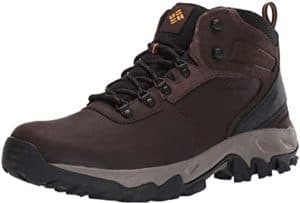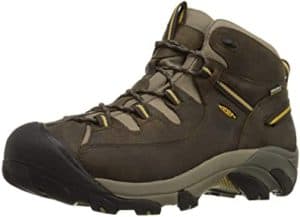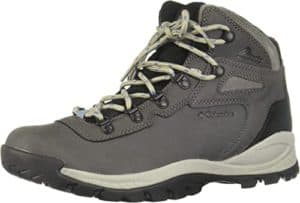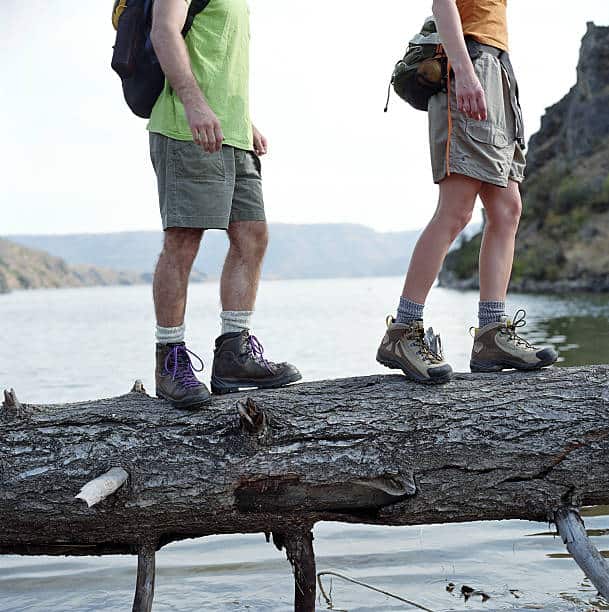You’ll need to slip your feet into a pair of the best hiking shoes in town if you’re trying to traverse an impossible mountain or just hit the trails this year. That might mean a new pair of Keen hiking boots or an excellent selection of Columbia hiking boots for those who want to go extreme. Good shoes keep your toes and feet safe from pressure, making you less vulnerable to foot pain and cramping.
In addition, good waterproofing can keep you comfortable, dry, and healthy while enjoying your outdoor excursions. You may not be a world-class explorer, but there’s no excuse for not taking advantage of the little comfort boost the best hiking boots for men provide.
Reasons to buy leather hiking boots:
- Comfortable to wear for a few hours;
- Premium quality that will last for years;
- Soft and durable at the same time;
- Water-resistant or even fully waterproof; Lightweight;
- Lightweight;
Timberland men’s white Ledge boot
 Timberland Men’s White Ledge Mid Waterproof Ankle BootAt the ankle, this Timberland product is secure and well-padded. You’ll tighten this boot on foot with four lower and two upper eyelets; however, none of these eyelets have a positive lock, which limits the ability to change the fit.
Timberland Men’s White Ledge Mid Waterproof Ankle BootAt the ankle, this Timberland product is secure and well-padded. You’ll tighten this boot on foot with four lower and two upper eyelets; however, none of these eyelets have a positive lock, which limits the ability to change the fit.
Since this product lacks a waterproof lining, it breathes very well for a full leather boot.
The wide forefoot sole provides an excellent foundation. The solidly padded collar feels great, but the ankle does nothing to stabilize it. At the same speed, the Hi-Tec Altitude, a bit close, offers better ankle stabilization and foot support. This boot has a wide heel and is pretty secure on rough terrain.
One of the highlights of this hiking boot is its exceptional grip on wet ground. Timberland’s patented rubber is flexible and ages faster.
The boots are waterproof, thanks to the very few seams in their construction. Their uppers are made of full-grain leather manufactured in the LWG Silver-rated tannery. The boots feature secure lacing provided by rustproof, quick lacing hardware with lace hooks at the top.
By buying these Timberland boots, one can get relatively light and easy-to-wear boots, as the White Ledge Boot weighs only 1.1 pounds. It has 12 x 9 x 6 inches and a shaft measuring about 4.75″ from the arch.
Pros
- Seam-sealed construction adds water resistance;
- Perfect weight to quality ratio;
- True to size;
- It can be worn right out of the box;
- A sturdy rubber outsole ensures a stable foot; a Gusseted tongue keeps your feet secure;
- A gusseted tongue keeps your feet safe from debris.
Cons
- Not insulated and, therefore, not particularly warm;
- Waterproofing ability may fade;
This is a perfect option for those who hike regularly and need a sturdy leather boot for working, planting, or gardening.
Columbia Men’s Newton Rige Plus Ii Boot
 Columbia Men’s Newton Ridge Plus II Waterproof Hiking BootFor long-lasting support, excellent cushioning, and high energy return, the Newton Ridge Plus II boots offer lightweight, sturdy midsoles and a rubber outsole with enhanced traction for slip-free travel over rough terrain.
Columbia Men’s Newton Ridge Plus II Waterproof Hiking BootFor long-lasting support, excellent cushioning, and high energy return, the Newton Ridge Plus II boots offer lightweight, sturdy midsoles and a rubber outsole with enhanced traction for slip-free travel over rough terrain.
If you’re looking for a decent boot in a wide range of sizes (7-17), this is a pair to try. In terms of fabric, they seem to have put a little bit of both. For breathability, you get the warmth and security of full grain leather mixed with lightweight suede.
For the outside of the shoe, the waterproofing is excellent. The laces tie tightly and, if finished properly, won’t slip. The soles are adhesive and can handle gravel, dirt, water, and other trail debris.
The rubber outsole features advanced high-traction grip technology for slip-free movement, even on wet terrain. The boots offer high shock absorption and energy return to their wearers.
Lace-up closure ensures that the fit is adjustable and secure.
Pros
- Soft sole grips well, preventing slippage;
- Lightweight;
- Mesh’s tongue adds breathability;
- Available in multiple colors;
- The signature midsole provides superior cushioning.
Cons
- Sole wears out fairly quickly; Not waterproof
- Not waterproof;
- Fits a specific foot shape well.
This Columbia Men’s Newton Ridge Plus II Waterproof hiking boot can be an excellent choice for hikers on the trail or any other slippery terrain.
These boots effortlessly blend ruggedness and comfort while being lightweight yet flexible footwear.
The traction-enhanced outsole works hard to ensure grip in any environment. The signature lightweight midsole provides long-lasting support and excellent cushioning for shock absorption and high energy return.
Merrell Men’s Moab 2 Boots
 Merrell Men’s Moab 2 Mid Waterproof Hiking BootMerrell’s Moab II boots look rooted, but they’re thin enough, practical enough, and at $100, they’re one of the best prices on the market. They’re comfortable right out of the bag with a padded collar and tongue, a sturdy footbed, and enough versatility to get you on the trail.
Merrell Men’s Moab 2 Mid Waterproof Hiking BootMerrell’s Moab II boots look rooted, but they’re thin enough, practical enough, and at $100, they’re one of the best prices on the market. They’re comfortable right out of the bag with a padded collar and tongue, a sturdy footbed, and enough versatility to get you on the trail.
As the miles add up, the extra cushioning gives the shoe a custom feel that potentially adds to the exceptional comfort during long days on the trail.
For the Merrell Moab 2, one of the most significant improvements is the inclusion of two silicone strips embedded in the upper material that run lengthwise on the inside and outside of the foot. These bands should have more structure and decrease the chances of turning an ankle.
Pros
- Cheap;
- Breathable mesh lining;
- Foam tongue to keep moisture out; Rubber toe caps for protection
- Rubber tips for safety;
- Flexible;
- Lightweight;
- Refined insoles;
- Ankle Protection;
Counter
- Difficult to clean;
- Not fully waterproof;
- Not suitable for technical terrain;
The Moab 2’s primary customers are day hikers, and the shoe promises moderate comfort and support accordingly. With a few months of use, the Moab can hold up quite well in terms of durability. The mesh along the upper material is a possible drawback to consider.
KEEN Men’s Targhee II Boot
 KEEN Men’s Targhee II Mid Waterproof Hiking BootThe Keen waterproof hiking boot gives your feet four-wheel-drive efficiency. It’s built to keep your feet dry so they can breathe and bite into the terrain with the aggressive outsole. The high mid-cut adds ankle support.
KEEN Men’s Targhee II Mid Waterproof Hiking BootThe Keen waterproof hiking boot gives your feet four-wheel-drive efficiency. It’s built to keep your feet dry so they can breathe and bite into the terrain with the aggressive outsole. The high mid-cut adds ankle support.
The ESS shank offers torsional stabilization for a comfortable ride, while the mid-cut height enhances ankle protection through canyons and mountaintops.
This boot covers the foot comfortably, from the cozy dual-density insole to the ankle collar. The rigid protective rubber in the front prevents the risk of stubbing your toes, and without creating foot pain or exhaustion, the thick sole with shank insert handles rocky terrain and jagged rocks.
Pros
- Cheap;
- Waterproof;
- High Grip;
- Good ankle support;
- Regular and wide fit ;
Disadvantages
- Heavy;
- Average stability ;
- Poor breathability ;
- Lack of durability;
The Targhee II Mid can be a solid option if you don’t have a lot of money to spend and want to hit the trails. Crossing all-terrain, you should be safe, as Keen’s patented outsole offers exceptional dealings on almost any rock form.
Columbia Women’s Newton Ridge Plus boot
 Columbia Women’s Newton Ridge Plus Waterproof Hiking Boot Columbia’s Newton Ridge Plus Amped Women’s Boots are one of the most common and highly comfortable pairs of women’s hiking boots. They are constructed with a trendy blend of mesh and leather made completely waterproof to a stylish suede finish.
Columbia Women’s Newton Ridge Plus Waterproof Hiking Boot Columbia’s Newton Ridge Plus Amped Women’s Boots are one of the most common and highly comfortable pairs of women’s hiking boots. They are constructed with a trendy blend of mesh and leather made completely waterproof to a stylish suede finish.
In a high-quality mid-range hiking boot, they offer everything you could want: a practical and lightweight construction, a waterproof and breathable finish, beautiful outsoles for rubber traction, and a supportive midsole.
Pros
- Affordable;
- Comfortable;
- Secure fit;
- Adjustable lace-up closure;
- Many colors and sizes;
- Waterproof;
Cons
- Heavy
- Lacks breathability
- The underfoot support could be better;
These boots suit outdoor lovers who enjoy hiking all year long, whether in rain, snow, or sunlight. They fall in easily and are perfect for or if you’re transitioning into hiking for shorter hikes. They come at an excellent price as well.
Buyer’s Guide
Types of leather hiking boots
Low boots have more flexible midsoles. They are mostly recommended for day hikers;
Day hiking boots can do the trick for short trips. They have an average break-in time but are still inexpensive and durable;
Hiking boots are recommended for heavy loads and long trips. They are usually expensive and high boots.
Material
Materials matter because they influence the boots’ breathability, waterproofing, and durability. When it comes to leather hiking boots, it is essential to pay attention to these materials:
- Full-grain leather is durable and water-resistant;
- Suede looks stylish and friendly but lacks waterproofing;
- Nubuck leather is similar to suede. Nubuck leather looks like suede but is known for its flexibility and strength. It requires a break-in period;
- Split grain cowhide leather combined with nylon mesh makes for lightweight boots. However, it is less resistant to water and tears;
- Vegan leather is good for the user who does not want to wear boots made with animal ingredients. Most of the time, vegan leather is made of polyester. It is lighter than natural leather but less durable ;
Weight
Hiking boots are much more durable and heavy, unlike shoes or running shoes. Lightweight shoes are great for mobility, stability, and comfort, which are the main factors for hikers. It’s doubtful that for less than 3.5 pounds, you’ll get a sturdy pair of men’s hiking boots, and there are several explanations for this. The extra insulation, padding, and cross-stitching used in the design and development of hiking boots will increase the weight of the finished product, but these elements are necessary.
Lightweight hiking boots are great for day trips and quick transport, while medium-weight choices are perfect for hiking and camping trips. The heavier they are, the better for the true multi-day hikers. You’ll need some weight and stamina, whether coming in over rough terrain or carrying a heavy load.
Support
Where running shoes rely heavily on stability and rebound cushioning, hiking shoes need structure and safety cushioning. Running or hiking on the uneven or rough ground can be risky, sometimes contributing to accidents and ankle concerns. When hiking, the last thing you want to worry about is getting injured and having to be removed from a dangerous situation. With a lot of protection and cushioning, it’s worth looking for a great pair of hiking boots.
Fit and Size
This is a matching method for choosing the best hiking boots. You need to sync your perfect hiking shoes with how and where you are hiking. But before you tie the knot, you must also ensure that they fit perfectly.
Hiking shoes everywhere can match a fit, close nowhere, and leave room to wiggle your toes. At the end of the day, after your feet have swollen) and with the socks you plan to wear, try them on.
Know your boot size. With a specially calibrated fitting device/application, it is best to assess your foot’s length, width, and arch length. The volume of the foot, another key to a good fit, should be assessed in-store by a specialist.
With the brand’s size cards, you can even test the length of your foot to find your size. Later, recheck the length by removing the soles of the boots and standing on them – the amount of space between the highest toe and the end of the sole should be one inch.
Try on sneakers. During the day’s events, feet usually swell a bit and would then be at their peak. This allows you to stop buying boots that are so tight.
Tips for leather hiking boot users:
- Socks are important. The thickness of the familiar socks should match your hiking boot use. On the trail, it’s best to stick with synthetic socks rather than cotton. Because cotton socks can cause you to get blisters faster;
- Before a long trip, spend time in new boots;
- When you buy online, choose the brand you’ve worn before. Because respectable brands use the same foot patterns over time and the fit stays similar to the size;
- The lacing system is also essential. If you don’t feel comfortable, lace the boots differently;
How to choose the proper leather hiking boots
The first thing is the environment:
- What kind of conditions are you going to be hiking in?
- Are you going to the desert?
- Are you going to the mountains?
- Do you need good toe protection?
- Do you need protection from cold water or cold weather?
- Do you need protection from rain and snow?
- Is it going to be hot?
- Are your feet going to be very sweaty?
All of these things go into the decision.
And then another factor in the decision process is how much weight you plan to carry? So if you’re carrying a heavy load, you want to minimize the risk of ankle injury by wearing a boot that better supports the ankle. Timberland boots are great boots you can wear in many places, including the Jordan Trail and beyond. And this was a great pair of boots for a hot climate, but there are a lot of good points to breathe in here. So it was super awesome.
If you’re getting in and out of the water, you must take something light like a trail runner. That wicks the water away. Instead of being a big boot going to get wet and hold that water for long periods, you’re just going to be lugging around heavy, wet boots. So if you’re doing a river run or something like that, choosing a lightweight trail runner is a great option.
You have almost no toe protection. You have almost no ankle support. The good thing is that it’s breathable, and your feet feel good and free, but if you’re doing more than five or six miles, something like this or akin or something similar in the sandal world will not be so great for your feet. It leaves you exposed, and you’re more likely to get, if not an injury, a blister, at least a hot spot, or something like that.
There are, of course, many different brands and styles of boots, and it’s up to you to choose what you like best. The most important thing is to be reassured, to know what’s going to be good not only at the first mile of the trail but also at mile 15, at mile 30, at mile 50 because hiking and backpacking are cumulative, so what may be good at the trailhead is not good later. So you want to take the necessary precautions to protect your feet no matter what.
And also, if you’re going on four-season or winter hikes, it’s essential to have some insulation in your shoes.
So if you’re a novice hiker and go to the store, one of the essential things to consider is to feel what’s comfortable in the store and take them out and test them.
Before you go hiking, it’s recommended that you walk at least five miles in a row with a backpack, with some weight on your feet, and see what it’s like, because it’s different when you’re carrying a heavy load, and you’ve walked a lot of miles then it is when you’ve just walked two aisles in the store.
